Parahelicomyces talbotii (Goos) S.Y. Hsieh, Goh & C.H. Kuo, comb. nov. Figs. 4, 5.
MycoBank number: MB 837333; Index Fungorum number: IF 837333; Facesoffungi number: FoF 12027;
Basionym: Helicosporium talbotii Goos, Mycologia 81: 368 (1989).
≡ Helicosporium ramosum P.H.B. Talbot, Bothalia 6: 493 (1956) [non Helicosporium ramosum (Berk. & M.A. Curtis) Massee, 1893].
≡ Pseudohelicomyces talbotii (Goos) Y.Z. Lu & K.D. Hyde, Fungal Divers. 92: 252 (2018).
Colonies on natural substratum effuse, white, cottony, pulverulent. Mycelium mostly superficial and partly immersed, composed of branched, subhyaline to fuscous, smooth-walled, septate hyphae, 2.5–4.5 μm wide. Stalked-sclerotia absent. Conidiophores macronematous, mononematous, arising from superficial repent mycelium, branching below, anastomosing, straight or flexuous, subhyaline to very dilute brown, 3–9-septate, bearing small cylindrical conidiogenous tooth-like protuberances along the shaft near the septa, (74–)100–245 μm long, (2–)2.5–3.5(−4) μm wide. Conidiogenous cells cylindrical, monoblastic or rarely polyblastic, sometimes bladder-like and bearing minute tooth-like projections. Conidia hyaline, 16– 18.5(−20) μm diam, coiled (2.5–)2.75–3.25 times; conidial filament hygroscopic, smooth-walled, indistinctly 21–23(−26)-septate, 1.5–2 μm thick, conidial secession schizolytic. Secondary conidia absent. Teleomorph unknown.
Specimens examined: TAIWAN, CHIAYI COUNTY: Fanlu Township, Huoshauliao (23.48000–120.62108, 761 m a.s.l.), on debarked wood submerged in a freshwater stream, 13 May 2016, leg. Chang-Hsin Kuo, NCYU-CC4-3. ibid. (23.47621–120.64211, 573 m a.s.l.), on a decaying culm of Miscanthus floridulus (Poaceae) submerged in a freshwater stream, 5 Feb 2017, leg. Chang-Hsin Kuo, NCYU-H3-2.
Known distribution: Japan, Mainland China, Mexico, South Africa, Taiwan, Thailand.
Note: This species is a new record for Taiwan mycoflora (Taiwan Biodiversity Information Facility 2020). We have not successfully obtained a living culture of this species collected from Taiwan for DNA sequencing. Identification of this species is therefore based on morphological data. The key identification features of this species are the white powdery colonies on natural substratum, with pale conidiophores arising from superficial repent mycelium, bearing primarily tooth- like cylindrical conidiogenous projections along the shaft.

Fig. 4 Parahelicomyces talbotii (NCYU-CC4-3). a Conidiophores arising from repent hyphae. b–j Conidiophores, bearing cylindrical tooth-like conidiogenous projections along the shaft. k–z Conidia. Scale bar: a–z = 10 μm

Fig. 5 Parahelicomyces talbotii (NCYU-H3-2). a, b Conidiophores, bearing cylindrical tooth-like conidiogenous projections along the shaft. c–o Conidia. Scale bar: a–q = 10 μm
